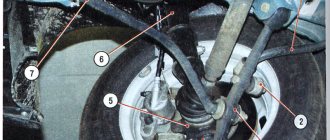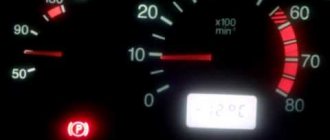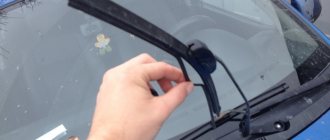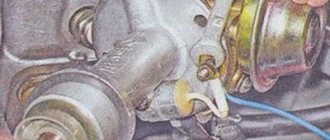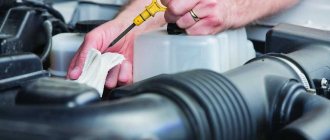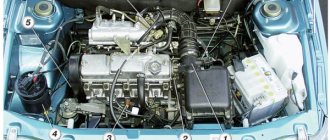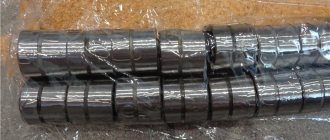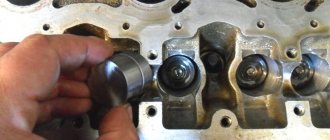Front suspension "Lada Grants"
It has an independent suspension with wishbones and a stabilizer bar. Damping of vibrations is carried out by hydraulic shock absorbers. The main structural element is the stand. It includes a swivel bearing, shock absorber and spring. The latter uses coils of variable diameter. The spring itself is made of a metal rod with a circular cross-section. It can have variable and constant hardness.
The front suspension of the Lada Granta is designed so that the lower part of the strut rests on the steering knuckle. When the wheels turn, the spring and shock absorber rotate with it. The stand itself remains motionless. Thus, the engineers achieved an increase in the service life of the elastic element while maintaining the inlet hole in the shock absorber body.
The pillar support has also been improved. Suspension creaking on the Lada Granta appears much less frequently than on Kalinas and Priors. To reduce roll, the design includes a stabilizer bar. It is made of spring steel. The stabilizer is installed with its ends to the lower suspension arms. Its middle part is fixed to the body.
Owner reviews of the Granta suspension
The opinions of motorists are largely similar. They note a number of advantages of the suspension system:
- for Russian roads it has a strong and reliable design;
- at very low temperatures it does not freeze and works out all the irregularities;
- capable of “swallowing” even deep holes without much damage;
- The car does not pull to the side at high speed when driving on the highway.
There are also disadvantages:
- the suspension is not soft and smooth;
- Unlike Logan, with which the Grant is often compared, the chassis is clearly stiffer.
In general, this is the same suspension system from the “nine” with minor changes, but for the Russian automotive industry this is a big step forward. Especially when you consider that the condition of the vehicle depends entirely on your driving style.
The unpretentiousness, simplicity and reliability of the chassis are the pride of Granta. There is one minus: the suspension with negative caster of the front wheels, front anti-roll bar and negative camber of the rear wheels is installed exclusively in modifications above the basic one - “Norma”, “Lux”. For owners of the “Standard” configuration, a suspension option borrowed from Kalina is provided.
Rear suspension
Unlike the front, it has undergone virtually no changes. Here, just like on the first Soviet G8s, a semi-independent beam is used. It is attached to the body on hinges (fortunately, there are no “crabs” in the design). A helical spring with constant stiffness is used as an elastic element. To dampen vibrations and prevent swinging, two shock absorbers are used.
The elements come from the factory are oil type. The spring is fixed together with the shock absorber. This greatly simplifies maintenance work, but has a negative impact on handling. Often the rear axle skids when cornering. But despite the archaic design, the owners speak positively about this suspension and highlight a number of advantages:
- High reliability. The design does not have additional levers, which, in addition, can bend when falling into a large hole.
- Energy intensity. The Lada Granta absorbs all bumps perfectly, especially if oil shock absorbers are installed at the rear.
- Cheap maintenance. Due to its simple design, this pendant can be rebuilt even with your own hands. And the cost of new rubber-metal elements is unlikely to empty the pockets of even the most stingy car owner.
The main difference between the “Grant” suspension is the wheel alignment angles.
They have a positive camber of about 0.1°). On Priora, for example, this figure is -1 degree. Next, we will consider the main malfunctions of the chassis on the Lada Grant.
Basic faults
To recognize faults in the chassis of the Lada Granta, it is not necessary to seek help from specialists. Problems can be easily identified on your own. The main suspension faults are presented in the table:
| When the car is moving, a knocking sound is heard from the suspension | |
| Hydraulic shock absorbers are faulty | Repair racks or replace them |
| The bolts that secure the anti-roll bar have become loose. Rubber cushions worn out | Tighten bolts and replace heavily worn pads |
| Unreliable fastening of the upper strut support to the body | Tighten the support nut |
| The rubber bushing of the shock absorber mount is worn or damaged | Replace part |
| Severe wear on the hinges of the suspension linkage system, damage to the braces or stabilizer | Replace worn and damaged parts |
| The ball joint of the lever is badly worn | Install a new ball joint |
| The spring sank, the coils were broken | Replace both springs |
| The shock absorber rod stroke buffer is damaged | Set new buffer |
| Steering wheel imbalance | Balance all wheels |
| Oil smudges on the rack | |
| The shock absorber seal is badly worn | Change the oil seal or shock absorber |
| Damage to the rod (scuffing, wear of the chrome coating) | Replace shock absorbers |
| Warped, damaged or worn strut O-ring | Replace ring |
| When the rod moves upward, there is not enough shock absorber resistance | |
| Recoil valve or bypass valve is leaking | Replace damaged parts or entire shock absorbers |
| There is a leak and there is not enough oil | Eliminate the malfunction and add oil |
| Seizures on the inner surface of the cylinder and piston | Replace elements and change oil |
| Secondary plastic bushing is damaged | Change the bushing |
| Contamination of the working fluid | Change oil |
| At the compression stage there is not enough shock absorber resistance | |
| Compression valve leaking | Fix the problem or replace parts |
| Low oil level in the rack | Fix leak and fill with oil |
| Rod or bushing is worn | Replace damaged elements |
| Liquid is contaminated | Replace working fluid |
| Compression valve discs are worn or deformed | Replacing parts |
| Suspension “breaks through” | |
| Spring wear | Install new springs |
| The shock absorber has failed | Restoring or installing new shock absorbers |
| The clearance in the ball joints is too large | |
| Wear of the ball joint due to dirt entering through a leaky boot | Remove the hinge and install a new one |
| The car does not move exactly in a straight line | |
| Tire pressure is uneven | Equalize the pressure in all tires |
| The wheel alignment angle is incorrect | Set the correct angle |
| Wear and destruction of rubber elements on one of the racks | Dismantle and install new rubber elements |
| The spring stiffness of the struts is not the same | Find and replace a spring with insufficient elasticity |
| Tires wear differently | Install new tires |
| The steering wheels are out of balance | Balance the wheels |
| Wheel tread wears out a lot | |
| Frequent sudden starts with possible slipping | Avoid aggressive driving style |
| Using brakes with full wheel locking | When braking, try to avoid blocking |
| The wheel alignment is incorrect or the vehicle is overloaded | Carry out wheel alignment and do not exceed the permitted load, which is indicated in the car's passport |
| Tires wear differently | |
| Taking corners at high speed | Reduce speed when turning |
| Worn ball joints of levers and rubber silent blocks | Replace parts |
| Wheel balancing is out of balance | Balance the wheels |
Most of the problems described can be easily diagnosed without the need to visit specialized service stations. You can do the repairs yourself, but after all the manipulations you definitely need to do a wheel alignment.
Shock absorber
This element is a damping device. The shock absorber serves to reduce the range of vibrations of the car body. In other words, the element prevents spontaneous rocking. The work of the shock absorber is based on hydraulic resistance. Inside it there is a liquid of a certain viscosity. It moves through a special valve. Thus, the device absorbs sharp impacts while preserving vulnerable suspension parts. Therefore, the shock absorber is one of the most important components in the chassis. On our roads, this element lasts about 60-80 thousand kilometers. But this period may be shorter, even with careful driving. It is enough just to damage the protective boot, and all the dirt will accumulate in the rod seal.
The rear shock absorbers suffer the most wear because they have much longer stroke. When driving quickly through potholes, the hydraulic fluid may simply boil. This is one of the reasons why a shock absorber fails. But most often it leaks - the valve loses its tightness due to a strong breakdown or impact. As a result, the outer side of the cylinder becomes coated with an oily liquid. How to determine that this element has failed? It’s very simple - you will hear a characteristic knock in the suspension of the Lada Granta. Moreover, it is clearly visible in the cabin. From the outside, you can hardly hear a broken shock absorber. This knock is so strong that even good music cannot interrupt it. You will hear a broken shock absorber immediately.
Also note that the damping element changes in pairs. That is, in the event of a breakdown of the rear left shock absorber, the rear right shock absorber also changes. As for the front struts, they are more durable. Often they are replaced already assembled with a spring, since they fail no earlier than after 150-200 thousand kilometers.
Chassis
Brake system
The Granta has brakes: discs at the front and drums at the rear. We could have ended there, since the service life of disc rotors, pads and calipers is not very long, but sufficient, and their price is low. ABS is common, fortunately all trim levels above the “Standard” relied on it, although the “Norma” sedan version may not have it.
The bulk of the complaints concern the rear drum brakes and frankly unsuccessful drum cylinders. The design itself is not bad, although the high efficiency is achieved due to the large diameter of the composite drums with an aluminum body. But they “sag” a little over time, and therefore they are often replaced with all-cast iron ones, which are very heavy, which affects the driving characteristics. True, it is not the housing that fails, but the historical hydraulic cylinder, without limiters, with poor sealing and a short service life. It can leak over runs of up to hundreds of thousands of km, but whatever! – and at 40-50 mileage there are enough cases of leaks. Well, replacement, as you understand, involves a complete overhaul of the mechanism. It's not that expensive to rebuild, but often the rear brakes on cars without ABS are simply disabled. And some owners are trying to improve braking by turning off the rear axle brake force regulator. Numerous videos of Grants skidding when braking are precisely the result of such intervention.
Against the backdrop of problems with the rear brakes, increased noise from the front calipers, weak pins and boots that require constant monitoring are trifles. Fortunately, the consumables cost just a penny: for a hundred rubles you can buy a pack of spare parts in the nearest store. Buying a new caliper of quite decent quality, and even more so - fresh rotors and pads is also not a problem, prices are extremely low with generally good quality. True, fakes and frankly “crooked” copies are very common. At VAZ, alas, they still rivet the consumables “on the knee”.
Rotting tubes and swelling hoses are found mainly on cars in “advanced” years - all these elements serve their five years honestly, but after that it’s up to you to see how it goes.
For those who lack the standard brake system, and there are many of them among Grant owners, literally everything can be redone. Fortunately, there are certified HA kits, and enlarged rotors for the front wheels, and options with notches, perforations, and simply from good brands. Every whim for your money.
The main thing to remember is that all alterations often actually lead to a decrease in the efficiency of the brakes, because the standard ones were not so bad and were still made by engineers, and not by garage “practitioners”.
Suspension
The Granta also has a suspension, and what a charm it is. It is precisely for these suspensions that people in the outback still love VAZ. Here the ground clearance is good, the moves, and the energy consumption are quite decent. Cars in the “Standard” configuration are usually equipped with a basic suspension with classic twin-tube shock absorbers, while the “Norma” and “Lux” have gas-filled ones. Both the springs and the stabilizer are different. In any case, the brand is SAAZ, the markings of the first suspension elements, shock absorbers and springs start at 2190, and the second - from 21980.
In theory, the second option should handle better, but in fact both are designed more for confident driving on very bad roads and comfort. If you need controllability, then there are modification kits. Moreover, the scale is impressive; you can even buy a front subframe with wishbones. Thanks to the “factory tuning” in the person of Granta Sport with its sports tubular arms on the subframe and Demfi struts, which set a good standard for the quality of suspension tuning.
As in the case of brakes, in practice it is not so easy to obtain excellent handling by installing any tuning elements; many modifications lead to its deterioration. But installing upper and lower braces and stiffer crabs usually gives the maximum result for a car without special preparation of the body and rear suspension.
The peculiarity of the Granta suspension is that its front MacPherson strut is very archaic in design. There is no subframe, the rack is located high on the engine shield, and a scheme is used with the main support arm and a stretcher arm attached to a forward bracket (the so-called “crab”).
The main advantage of such a suspension is comfort and low quality requirements for rubber products in its composition. The disadvantages are the high compliance of literally all attachment points of the levers relative to the engine shield and rack and, as a consequence, the difficulty in adjusting the handling and its dependence on the design solutions of the body.
At Grant, the designers already understood the basic principles that gave the 2108 sharp steering, and the 2110, on the contrary, jelly steering, so that even the basic cars had taxiing and comfort characteristics that were quite acceptable at the beginning of the 2000s. But with an emphasis on comfort, of course.
In addition to constructive ones, there are other disadvantages. Thus, high bending moments acting on the strut support cup are not supported by the strength of the body, and as a result, the standard support amplifier and the cup itself bend. And the strut support suffers, although modern Grant ones are made with a large bearing, similar to foreign ones.
The high variable load on the front end of the spar does not have the best effect on the durability of its seams, and the strength of the tension brackets is always insufficient; making them stronger means worsening the already poor passive safety of the body. And for confident movement in the style of “more speed - fewer holes”, the strength of the standard one is not enough.
The rear beam is structurally almost ideal, but it has no margin of safety at all. Soviet weight discipline is still noticeable. As a result, its properties as a torsion bar for anti-roll bar are not very pronounced. And she really needs a separate stabilizer to help.
Okay, enough theory. In a large city like Moscow or St. Petersburg, the resource of the Grant suspension is limited mainly by the aging of rubber elements due to chemistry and has little to do with loads, unless we are talking about minor accidents and impacts on curbs. It confidently withstands its four to five years and a hundred to one and a half thousand kilometers, gradually losing the characteristics of the shock absorbers, especially quickly - the rear ones, which do not like loads. At the same time, the front support amplifier is bent. At high peak loads, the corresponding elements, bracing brackets, supports, and, less often, the transverse arms of the front suspension are usually given out.
To make a tragedy out of suspension repairs on a Grant means to be either a formalist or a very greedy person. Prices for decent spare parts are at the level of a mid-range budget foreign car and even lower.
Of course, you won’t achieve the legendary “Mercedes” suspension mileage, nor comfort, but in general you can get good performance for an inexpensive price. And you don’t need to order anything; completely normal spare parts can be found in any corner of the country. But, as with other spare parts for VAZ, you need to be careful: silent blocks made of raw rubber and brackets made of recycled materials, re-painted used shock absorbers are found on sale alarmingly often.
Steering
The rack here is simple mechanical and well known to at least two generations of mechanics. It lasts 150-200 thousand if you keep the anthers intact and do not abuse off-road driving and flying over uneven terrain.
On cars with an electric power steering there is a shorter one, on cars without an amplifier there is a longer one, but they are structurally similar. The attachment to the engine shield is not very good, but the design is clearly forged in the fire of the old school of engineering. In the sense, it is optimized for minimum production cost, weight and acceptable resource.
The EUR on the Grant is an add-on for the steering column, and it exists in two versions. The domestic gearless one from Avtoelektronika from Kaluga pleases with its steering quality, and the Mando from Korea is simply more reliable due to a better torque sensor, but it can jam at the most inopportune moment. Unfortunately, it is difficult to combine the advantages, and even the latest versions of the Kaluga electric power steering suffer from not very good soldering, including the torque sensor cable, but Mando seemed to be completely abandoned in 2014 after a loud scandal with a jammed steering wheel on cars for journalists. And it’s true: it’s better without power assistance than with a steering wheel that’s tightly jammed.
But in fact, you can find Korean amplifiers on later cars: for example, almost all Granta Sport are equipped with them. By the way, many owners of cars with electric power steering advise lubricating the amplifier gearbox by adding new grease using a grease nipple through the hole of one of the bolts. According to reviews, this significantly improves responsiveness in the near-zero zone.
As for the rest, it is worth noting the regular problems with cardan joints, the short service life of rods and ends (but how elegantly the nuts are locked on the factory versions). And also the low cost of all consumables.
Silent blocks
By 100 thousand, the silent blocks of the cross member and lower arms fail. Signs of a malfunction are a dull knock from the front suspension of the Lada Granta. Motorists recommend replacing these elements with polyurethane ones.
They are characterized by higher strength and good service life. At the factory, rubber silent blocks are installed that do not withstand the impacts of our roads. To replace, we need to press out the old element. First, the bead is cut off from it, and then knocked out using a mandrel or chisel. Pressing is done using a vice. It is important to maintain alignment and not mix up the installation side. For easier pressing, it is recommended to use lubricant.
The silent blocks of the anti-roll bar also fail. These bushings are also replaced with polyurethane ones.
Modernization of suspension systems
1. For front suspension:
2. For the rear suspension, the springs were strengthened and gas-filled shock absorbers were installed. It is worth noting that factory tuning of the suspension is combined with improved sound insulation of the car. With this modification, the car feels quite comfortable on the road up to 150 km/h, while coping well with cornering on almost any road surface.
A detailed analysis of the reliability of the suspension for the Lada Granta liftback is quite difficult to carry out. This is due to the short life of the car. Life tests of the machine are still ahead. However, based on reviews from owners and the results of warranty and service maintenance of these cars, we can characterize the main faults:
- loosening the anti-roll bar fixing bolts;
- failure of hydraulic shock absorbers (after 60-80 thousand km), leakage of shock absorbers;
- wear (increased clearance) of the front wheel bearings, which causes accelerated wear of the silent blocks of the levers;
- loss of spring stiffness (especially for springs with a smaller diameter);
- wear of the ball joints of the front suspension.
- the appearance of squeaks in the place where the shock absorber strut is attached;
- shock absorber failure;
- violation of wheel alignment angles, including due to violation of the adjustment of the clearance of the hub bearings or their destruction;
- Damage to the shock absorber protective covers.
This approach can easily be justified by the increased costs of deferred repairs. Worn bearings will place increased load on ball joints, rubber bushings of levers, and cause disruption of the alignment angles of the front wheels. Over time, the tires will begin to wear out faster. A sagging spring will not only lead to possible damage to the bumper on the first high curb. The shock absorber will wear out faster, and the car will lose comfort at high speeds.
Removing the rear suspension shock absorber strut on a Lada Granta car is done to replace a sagging or burst spring, as well as to replace the shock absorber itself or repair it if it is dismountable and you have the appropriate repair kit.
Prepare a standard set of tools and perform the following sequence of actions:
- Inside the car, fold down the back of the rear seat and use a flat screwdriver to pry off the rubber plug of the shock absorber strut cup.
- We remove the rubber plug, then use a socket and a regular open-end wrench to unscrew the nut of the upper fastening of the shock absorber rod to the car body.
- We install stops under the front wheels and hang the rear part of the body, remove the wheel from the side being repaired.
- Unscrew the nut of the bolt securing the lower shock absorber to the rear beam bracket.
- We remove the lower end of the rack from the bracket and remove it along with the spring.
- Remove the spring from the shock absorber along with its rubber spacer. Next, remove the bushing and lower cushion along with the boot from the rod. All rubber elements must be replaced if the rubber has lost its elasticity, is severely cracked, or has other defects. Don't forget to remove the rubber compression buffer from the boot.
- Having completed the necessary repairs or replacement of worn elements, we proceed to install the rack. The installation sequence is performed in the reverse order of removal. First of all, using insulating tape, fix the rubber spacer on the upper end of the spring.
- We put the spring on the strut so that its end fits neatly into the corresponding groove of the shock absorber support cup.
- When installing, make sure that the lower end of the spring faces the wheel.
At this point, the repair work on removing and installing the rear suspension shock absorber strut on the VAZ 2190 has been completed.
The rear suspension of the car is semi-independent, made on an elastic beam with trailing arms, coil springs and double-acting telescopic shock absorbers.
The rear suspension beam consists of two longitudinal arms connected by a U-shaped cross member.
This cross-section provides the connector (cross member) with greater bending rigidity and less torsional rigidity.
The connector allows the levers to move relative to each other within small limits. The levers are made of pipes of variable cross-section, which gives them the necessary rigidity
Brackets for attaching the shock absorber, rear brake shield and wheel hub axle are welded to the rear end of each lever.
At the front, the beam arms are bolted to removable brackets for the body side members.
The mobility of the levers is ensured by rubber-metal hinges (silent blocks) pressed into the front ends of the levers.
The lower shock absorber eye is attached to the beam arm bracket. The shock absorber is attached to the body by a rod with a nut.
The elasticity of the upper and lower connections of the shock absorber is provided by rod cushions and a rubber-metal bushing pressed into the eye.
The shock absorber rod is covered with a corrugated casing that protects it from dirt and moisture. In the event of suspension breakdowns, the stroke of the shock absorber rod is limited by a compression stroke buffer made of elastic plastic.
The suspension spring with its lower coil rests on the support cup (a stamped steel plate welded to the shock absorber body), and with its upper coil it rests against the body through a rubber gasket.
The rear wheel hub axle is installed on the flange of the beam arm (it is secured with four bolts).
The hub with a double-row roller bearing pressed into it is held on the axle by a special nut. The nut has an annular collar that securely locks the nut by jamming it into the groove of the axle.
The hub bearing is a closed type and does not require adjustment or lubrication during vehicle operation.
Rear suspension springs are divided into two classes: A
- more rigid,
B
- less rigid.
A springs
are marked with brown paint, class
B
- blue.
Springs of the same class must be installed on the right and left sides of the car.
Springs of the same class are installed in the front and rear suspension. B springs may be installed
in the rear suspension if class
A
.
A springs
It is not allowed on the rear suspension if class
B
.
Checking the suspension condition
You can evaluate the technical condition of the suspension while the car is moving. When driving at low speed on an uneven road, the suspension should work without knocks, squeaks and other extraneous sounds.
After driving over an obstacle, the car should not sway.
It is better to combine checking the suspension with checking the condition of the tires and wheel bearings.
One-sided tire tread wear indicates deformation of the rear suspension beam.
Execution Sequence
1. We prepare the car for work.
It is better to check the performance of shock absorbers after a long trip, until the working fluid in the shock absorbers has cooled down.
2. Vigorously swing the rear part of the car body in a vertical direction.
If, due to inertia, the body continues to oscillate (more than two: up and down) after it has stopped swaying, it means that one or both shock absorbers are faulty.
To identify a faulty shock absorber, we repeat the test, applying force first on one side of the car and then on the other.
This check can only identify faulty shock absorbers.
The effectiveness of vibration damping by shock absorbers can only be checked on a special stand.
3. Inspect the suspension shock absorbers - fluid leakage from the shock absorbers is not allowed.
Shock absorbers should be replaced as a pair, even if the second shock absorber on the rear suspension is working.
4. Visually check the condition of the rubber-metal hinges for fastening the shock absorbers 1 and the arms of the rear axle beam 2.
We replace hinges with one-sided bulging of rubber, tears and cracks.
5. Check the tightness of the nuts securing the suspension parts and tighten them if necessary.
6. Inspect the suspension parts. Deformation and fatigue cracks in suspension parts are not allowed.
We replace damaged parts.
Replace springs, like shock absorbers, in pairs.
| Tightening torques for rear suspension threaded connections | ||
| Name of units and parts | Tightening torque Nm (kgcm) | |
| Wheel bolts | 65,2-92,6 (6,7-9,5) | |
| Rear wheel bearing nut | 186,3-225,6 (19,0-23,0) | |
| Shock absorber lower mounting bolt nut to the rear suspension arm | 66,6-82,3 (6,8-8,4) | |
| Shock absorber rod mounting nut rear suspension to body | 50,0-61,7 (5,1-6,3) | |
| Lever mounting bolt nuts rear suspension to bracket | 66,6-82,3 (6,8-8,4) | |
| Lever bracket fastening nuts rear suspension to body | 27,4-34,0 (2,8-3,5) | |
It is more convenient to remove the rear beam of the Lada Granta on a lift. If it is not possible to place the car on a lift, carefully raise the rear of the car by placing a jack under the beam. Then install supports under the jack sockets on the car body. As a result, the rear of the car must be suspended. Before you hang the rear, remove the wheels. Without wheels, it will be more convenient for you and your assistants to operate the beam. Loosen and tighten wheel bolts only with the vehicle on the ground. The tightening torque of the bolts is 65–95 N m (6.5–9.5 kgf m).
First of all, we wanted to once again show the structure of the rear beam, which will allow you to evaluate where and how the beam is attached to the body and to other suspension elements.
First of all, when removing the beam, it is necessary to disconnect it from the rear shock absorbers (9) and brackets (2), which are attached to the body.
Cause of malfunction
The main cause of element malfunction is a violation of the boot seal. Once it starts to crack, dirt and dust will get inside. They act on the ball like an abrasive. As a result, play appears and the support begins to break on its own. Is it possible to repair it? The Lada Granta suspension is designed in such a way that the ball joints cannot be restored and must be replaced entirely with new ones.
These elements are replaced as a set. The price of two balls is about 700 rubles. The service station will charge about 600 for installation. Although you can replace them yourself. All you need: a jack, a pit, a set of sockets and a special sprocket wrench. But please note that the bolts in this place may become sour. When replacing, there is a high risk of licking off the edges of the sprocket. Unscrew all bolts very carefully - do not press too hard. The service life of original ball joints is about 40 thousand kilometers.
Motors
Common problems
Grant's main problem is his service style. The use of the cheapest components and fluids, service literally in Petrovich’s garage, bypass technologies and more.
At the same time, we can safely say about any VAZ engine that it is very good. Maintainability and service life are high, especially if you maintain it as carefully as foreign cars and monitor the control system. The cost of maintenance and repair is minimal.
The design itself is extremely simple and has no obvious weak points. Almost all regular problems are due to not very successful components, and not to the design. Well, relatively often you come across motors with obvious defects - for 40 years the quality control system has not been fully established.
“Minor” electrical troubles are present in full - from poorly laid wiring to the service life of fans and sensors, weak connectors in the engine compartment and crooked radiators. And even branded thermostats have to be changed on a schedule, every second year, often together with expansion tanks after the first three years of operation. And if you’re unlucky, then right away.
Eight valve engines
The majority of cars are equipped with eight-valve engines of the 11183 and 11186 series. The simplest engine, 1183-50, is in practice one of the most durable. And even though the factory claims that it only lasts 200 thousand, in practice the service life is usually at least 300, and this is with the odometers constantly being twisted (most likely the market is full of copies with real mileage “over 500”). In any decent oil and under almost any load, except extreme.
A heavy piston group and an old timing mechanism with a wide belt look unfashionable, but in practice the fact that the engine is “not plug-in” and the service life of the piston group is very good outweigh almost all the positive factors of the modernized 11186 engines. Even a mechanical throttle with a troublesome IAC and an old thermostat in practice, there are not such terrible disadvantages, except that the consumption is higher and a little more hassle. But on 11186, during repairs, they often install just the old piston group, because the difference in fuel consumption and power is small, but it does not bend the valve, and you don’t have to worry about oil leaks. And if you need agility at the top, then there are 16-valve engines.
Unfortunately, there are also disadvantages here, and many. Almost everyone is familiar with VAZ cars of previous generations. The engine regularly leaks along the valve cover, it has a low resource of ignition modules, a short service life of the DPKV, a simple VKV, it constantly requires small hands, since the attachment requires regular checking. The fasteners either sour or unscrew, the valve clearances go away quite quickly in modern times, you need to check them every 30 thousand, the speed fluctuates, and the catalytic collector is rough and cracks.
Motors of the 11186 series are a product of deep modernization of the 83rd family. There's a new piston group from Federal-Mogul, fancy T-shaped pistons and lightweight connecting rods, as well as new liners. New sealed timing case so that the belt can last 120+ thousand kilometers. The new thermostat is installed directly on the cylinder head. The throttle is now electronically controlled. It is all optimized, lightweight and... ultimately more sensitive to oil change intervals and its quality, and after 200 thousand it easily falls into the sin of oil-guzzling.
True, there is usually no wear on the piston group, and decarbonization helps a lot. It has more delicate ignition coils, and the spark plugs should be changed more often. Its valves bend when the timing belt breaks, and the timing mechanism has not become super reliable, it just works a little quieter, but it’s still better to change the belt every 60 thousand, because it may not live up to 90, and it definitely won’t live up to 120, especially since the pumps The quality hasn't improved much.
New thermostats are unexpectedly no better in quality than old ones, but more expensive. The leapfrog with replacements begins even at mileages of up to hundreds of thousands. And the temperature sensor in the thermostat housing initially had a bad habit of leaking. The problem was fixed quickly, but the sensor is still being “ground in” in the housing.
A new fuel pump and power supply without “return” are a little simpler than the classic scheme, but the RTD is located in the tank, on the pump flask, and any replacement causes a lot of trouble. And the quality of the RTD is not at all foreign-made; the fuel pressure fluctuates noticeably even on new cars. Later versions have modernized “stickless” pistons and the same performance characteristics, but the other shortcomings have not gone away. One of the clear advantages is that the engine is noticeably quieter, and fuel consumption is lower than that of the 1183 family by almost a liter on average. In general, this is a good option for the development of eight-valve engines.
16 valve engines
16-valve engines are represented by variants 21126 with 98 horsepower, which are also equipped with cars with automatic transmission, and the newer 21127 (only cars with AMT). The newer engines are not only a little more powerful (as much as 106 horsepower), but also have a significantly redesigned design with a new adjustable intake manifold, a new control system with an absolute pressure sensor, as well as minor changes to the attachments and cylinder head.
Motors 21126 are a very successful “Prior” motor. With good power, boost reserves and quite resourceful. Like all 16-valve engines, it is equipped with hydraulic compensators, and also has a “federal” piston group and an optimized timing mechanism.
Actually, the shortcomings of the motor are a continuation of its advantages. Poor oil drainage from the pistons and slight coking, a high-temperature thermostat as much as 104 degrees, a timing mechanism with a thin pin, not very durable rollers and a pump and a thin belt in combination with “butt-in” pistons cause a lot of dissatisfaction.
The engine requires high-quality and regular maintenance, good oil and control. With 250+ miles and typical Zhiguli maintenance, oil appetite can no longer be attributed to leaks. And you need to constantly monitor the timing belt, the quality of the components is very unstable, belt breaks have happened at 40 thousand miles, and you shouldn’t ignore the howling of the pump or rollers, even if the car is completely new.
You can install a thermostat at 85 degrees, STK plug-free pistons, a high-quality pump and a reinforced belt - these are the main areas of improvement, in addition to updating the firmware. The latter, by the way, is not of the best quality in principle, from the point of view of driving pleasure. With noticeable delays in traction work, and the consumption is not so low, especially with an automatic transmission. As a result, engine performance can be significantly improved and the risk of serious breakdowns can be reduced.
"Shesnari" is significantly more complicated and more expensive to operate than 8-valve options, but the difference in power is clearly noticeable. In addition, the shortcomings are completely removable, and tuning fans adore it. Since July 2022, the piston group has been updated, pistons cost from 21129, and the valves no longer bend when the timing is out of order.
The engines of the 21127 line are newer, they have better VSKh, lower consumption, and the build quality has noticeably improved in recent years. A more complex intake manifold made it possible to make the engine noticeably more torquey at the bottom and a little more powerful, now the engine is more torquey than the old eight-valve engines.
The control system with an absolute pressure sensor is almost not subject to aging, while the mass air flow sensor is highly dependent on the cleanliness of the intake air, and the Bosch thin-film sensor is almost impossible to clean without opening it. Otherwise, it has the same disadvantages and advantages as 21126.
Wheel bearing
This element serves for uniform rotation of the car wheels. There are 4 such bearings on the Grant. On average, their resource is 100 thousand kilometers. What are the signs of a problem? The main symptom is a characteristic hum when moving. It may get worse as the car turns. The hum can occur on either side of the car, depending on which bearing has fallen apart. The entire assembly is replaced with a new one, and it doesn’t matter whether the Lada Granta’s rear suspension or the front one. It is pressed out using a puller with special paws. Pressing takes place in a vice. It is important to maintain alignment when pressing. If a bearing is installed crookedly, it will be subjected to high loads and may fall apart after just a thousand kilometers.
The main enemy of a bearing is moisture. Therefore, during installation it is so important to ensure the element is sealed. Some manufacturers cover it with a special cap (it is put on the fastening nut), which will prevent salt, water and other reagents from getting inside. But as soon as dust penetrates the bearing, the latter begins to operate outside of its temperature range. As a result, the lubricant is washed away, and the dirt acts as an abrasive. Untimely replacement of this element can provoke a sudden wheel wedge, which is fraught with consequences.
Possible faults
Malfunctions and breakdowns can occur in any car, especially with regard to the suspension. This is explained by the fact that the suspension endures constant vibration when driving, softens shocks, and takes the entire weight of the car, including passengers and luggage, on itself. Based on this, a Granta in a liftback body is more susceptible to breakdown than a sedan, since the liftback body has a larger luggage compartment designed for greater weight.
The first problem that is most often encountered is the presence of knocking or extraneous noise. In this case, it is necessary to check the shock absorbers, as they need timely replacement and can often fail. Also, the reason may be that the shock absorber mounting bolts are not fully tightened.
If this is not the case, then check the rubber bushings on the suspension support arms. They very often break when they fall into a hole, especially on a liftback body. Also, with a strong impact, not only the bushings can be damaged, but also the struts themselves. Then the repairs will be more serious and expensive.
The final cause of suspension knocking may be a broken spring. It is replaced literally within 5 minutes.
In addition to knocking noises, you need to check the suspension mechanism for leaks. If such traces are found, then this can only indicate one thing - a malfunction of the shock absorbers. If all the fluid leaks out and the shock absorber dries out, then when it hits a hole, the suspension will provide poor resistance, and the vibration from the impact will be very strong. The solution to this problem is quite simple - replace the worn element.
Since the Lada Granta in the liftback body is more subject to overloads, its owners often experience such trouble as: puncture of the rear suspension. This is due to exceeding the permissible weight on the rear axle of the car. With constant use in such conditions, shock absorbers and springs will very quickly become unusable.
failed shock absorbers are not uncommon
The last malfunction that occurs on the Grant is that when braking or accelerating, the car pulls to the side. This indicates that on this side, one or two shock absorbers are worn out and sag somewhat more than the others. Because of this, the body has an overweight.
